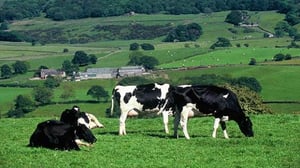The summer finally arrived in Ireland and most cattle have been turned out for a few weeks now. But have you started to think about a worming strategy yet?
Summer grazing means cheap grass and good growth rates and - unfortunately - summer parasites. To get the most from grazed grass, it is important to minimise the effect of the parasites that the livestock are exposed to.
 This includes to put a summer worming plan in place. When putting this plan together, it’s important to think long term as well as short. Over-using certain products can lead to the parasites becoming resistant to the product which is especially a problem for sheep wormers.
This includes to put a summer worming plan in place. When putting this plan together, it’s important to think long term as well as short. Over-using certain products can lead to the parasites becoming resistant to the product which is especially a problem for sheep wormers.
Traditionally, most farmers would treat on a 4-6 weeks basis when cattle are out on grass. This would have ensured an adequate coverage. The problem however with this approach is that you never know for certain if the treatment is either a) needed or b) effective. And improper use of the wormer can easily lead to worm resistance and unnecessary costs.
The only way to answer either of those questions with certainty is to test your livestock for worms and treat if necessary. The simplest way to test for worms or fluke problem is to do a faecal egg test. This is much more cost effective when compared with blanket treating a group of animals that do not require treatment.
Some cattle can tolerate small burdens of parasites depending on their age. So, it’s important to understand whether or not worming is necessary. Older suckler cows in particular are generally immune to both lung and gut worms if they have had exposure to it over their life time. The risk generally decreases with age, with calves and year-old cattle having the biggest potential negative effect from worm burdens.
There are a few simple methods which can be used to reduce younger cattle’s exposure to worms. The simplest and best-known method is the “Leader-follower system”, This involves having two grazing groups running side by side:
The younger cattle graze a paddock first. They eat the  longer grass, and after they have grazed, they are moved to the next paddock. The older cattle then follow them, eating the remaining grass, which is shorter. The basic principle of this is that the worms tend to be closer to the ground, and by letting the younger cattle graze the tops of the grass, they will be exposed to less parasites.
longer grass, and after they have grazed, they are moved to the next paddock. The older cattle then follow them, eating the remaining grass, which is shorter. The basic principle of this is that the worms tend to be closer to the ground, and by letting the younger cattle graze the tops of the grass, they will be exposed to less parasites.
We have put together a free worming plan that will allow you to manage your parasite control throughout the grazing season. You can get it by clicking on the button below.
Looking for a checklist? Get your free summer worming plan here:


